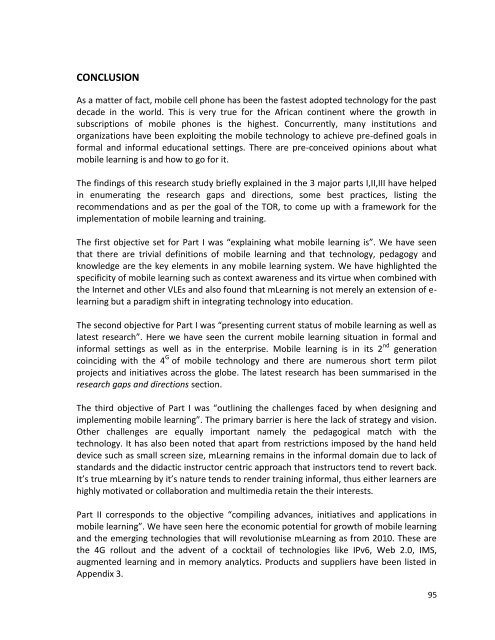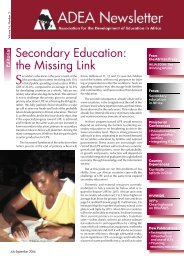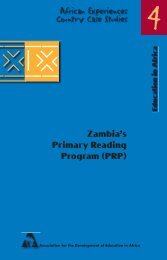Trends in Distance Education and Open Learning: Policy ... - ADEA
Trends in Distance Education and Open Learning: Policy ... - ADEA
Trends in Distance Education and Open Learning: Policy ... - ADEA
Create successful ePaper yourself
Turn your PDF publications into a flip-book with our unique Google optimized e-Paper software.
CONCLUSIONAs a matter of fact, mobile cell phone has been the fastest adopted technology for the pastdecade <strong>in</strong> the world. This is very true for the African cont<strong>in</strong>ent where the growth <strong>in</strong>subscriptions of mobile phones is the highest. Concurrently, many <strong>in</strong>stitutions <strong>and</strong>organizations have been exploit<strong>in</strong>g the mobile technology to achieve pre-def<strong>in</strong>ed goals <strong>in</strong>formal <strong>and</strong> <strong>in</strong>formal educational sett<strong>in</strong>gs. There are pre-conceived op<strong>in</strong>ions about whatmobile learn<strong>in</strong>g is <strong>and</strong> how to go for it.The f<strong>in</strong>d<strong>in</strong>gs of this research study briefly expla<strong>in</strong>ed <strong>in</strong> the 3 major parts I,II,III have helped<strong>in</strong> enumerat<strong>in</strong>g the research gaps <strong>and</strong> directions, some best practices, list<strong>in</strong>g therecommendations <strong>and</strong> as per the goal of the TOR, to come up with a framework for theimplementation of mobile learn<strong>in</strong>g <strong>and</strong> tra<strong>in</strong><strong>in</strong>g.The first objective set for Part I was “expla<strong>in</strong><strong>in</strong>g what mobile learn<strong>in</strong>g is”. We have seenthat there are trivial def<strong>in</strong>itions of mobile learn<strong>in</strong>g <strong>and</strong> that technology, pedagogy <strong>and</strong>knowledge are the key elements <strong>in</strong> any mobile learn<strong>in</strong>g system. We have highlighted thespecificity of mobile learn<strong>in</strong>g such as context awareness <strong>and</strong> its virtue when comb<strong>in</strong>ed withthe Internet <strong>and</strong> other VLEs <strong>and</strong> also found that mLearn<strong>in</strong>g is not merely an extension of e-learn<strong>in</strong>g but a paradigm shift <strong>in</strong> <strong>in</strong>tegrat<strong>in</strong>g technology <strong>in</strong>to education.The second objective for Part I was “present<strong>in</strong>g current status of mobile learn<strong>in</strong>g as well aslatest research”. Here we have seen the current mobile learn<strong>in</strong>g situation <strong>in</strong> formal <strong>and</strong><strong>in</strong>formal sett<strong>in</strong>gs as well as <strong>in</strong> the enterprise. Mobile learn<strong>in</strong>g is <strong>in</strong> its 2 nd generationco<strong>in</strong>cid<strong>in</strong>g with the 4 G of mobile technology <strong>and</strong> there are numerous short term pilotprojects <strong>and</strong> <strong>in</strong>itiatives across the globe. The latest research has been summarised <strong>in</strong> theresearch gaps <strong>and</strong> directions section.The third objective of Part I was “outl<strong>in</strong><strong>in</strong>g the challenges faced by when design<strong>in</strong>g <strong>and</strong>implement<strong>in</strong>g mobile learn<strong>in</strong>g”. The primary barrier is here the lack of strategy <strong>and</strong> vision.Other challenges are equally important namely the pedagogical match with thetechnology. It has also been noted that apart from restrictions imposed by the h<strong>and</strong> helddevice such as small screen size, mLearn<strong>in</strong>g rema<strong>in</strong>s <strong>in</strong> the <strong>in</strong>formal doma<strong>in</strong> due to lack ofst<strong>and</strong>ards <strong>and</strong> the didactic <strong>in</strong>structor centric approach that <strong>in</strong>structors tend to revert back.It’s true mLearn<strong>in</strong>g by it’s nature tends to render tra<strong>in</strong><strong>in</strong>g <strong>in</strong>formal, thus either learners arehighly motivated or collaboration <strong>and</strong> multimedia reta<strong>in</strong> the their <strong>in</strong>terests.Part II corresponds to the objective “compil<strong>in</strong>g advances, <strong>in</strong>itiatives <strong>and</strong> applications <strong>in</strong>mobile learn<strong>in</strong>g”. We have seen here the economic potential for growth of mobile learn<strong>in</strong>g<strong>and</strong> the emerg<strong>in</strong>g technologies that will revolutionise mLearn<strong>in</strong>g as from 2010. These arethe 4G rollout <strong>and</strong> the advent of a cocktail of technologies like IPv6, Web 2.0, IMS,augmented learn<strong>in</strong>g <strong>and</strong> <strong>in</strong> memory analytics. Products <strong>and</strong> suppliers have been listed <strong>in</strong>Appendix 3.95
















